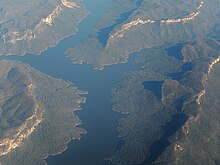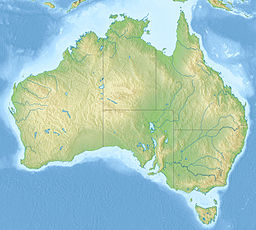Lake Burragorang
| Lake Burragorang | |
|---|---|
 The lake in January 2014 | |
| Coordinates | 34°0′S 150°26′E / 34.000°S 150.433°E |
| Type | Man-made water supply dammed reservoir |
| Primary inflows | Coxs, Kowmung, Nattai, Wingecarribee, Wollondilly and Warragamba rivers |
| Primary outflows | Warragamba River |
| Catchment area | 9,051 km2 (3,495 sq mi) |
| Basin countries | Australia |
| Max. length | 52 km (32 mi) |
| Surface area | 75 km2 (29 sq mi) |
| Max. depth | 105 m (344 ft) |
| Water volume | 2,031 GL (4.47×1011 imp gal; 5.37×1011 US gal) |
| Shore length1 | 354 km (220 mi) |
| Surface elevation | 110 m (360 ft) |
| 1 Shore length is not a well-defined measure. | |
Lake Burragorang is a man-made reservoir in the lower Blue Mountains of New South Wales, Australia, serving as a major water supply for greater metropolitan Sydney. The dam impounding the lake, the Warragamba Dam, is located approximately 60 kilometres (37 mi) southwest of the Sydney central business district.
Lake Burragorang is within the World Heritage Site of the Greater Blue Mountains Area. The 2,031-gigalitre (4.47×1011 imp gal; 5.37×1011 US gal) reservoir collects water from the converged flows of the Coxs, Kowmung, Nattai, Wingecarribee, Wollondilly, and Warragamba rivers and their associated tributaries, all within the Nepean and Hawkesbury River catchment.
Pre-lake history
[edit]Before the construction of the dam, Burragorang Valley had been inhabited by white settlers since the 19th century, and for thousands of years before, the Burragorang valley was part of the tribal lands of the Gundungarra nation, an indigenous tribe that called the Burragorang valley, along with the Blue Mountains and Megalong Valley, their tribal land. A number of farming towns (including the town of Burragorang) and coal mines were located in the area. All of these are now underwater.[1] Construction of Warragamba dam commenced in 1948 and was completed in 1960.
Capacity
[edit]
The reservoir's usable capacity is 2,027 gigalitres (4.46×1011 imp gal; 5.35×1011 US gal). Prior to April 2006, the usable capacity was 1,857 gigalitres (4.08×1011 imp gal; 4.91×1011 US gal), before the Deep Water Storage Recovery project was completed. There are fears, however, that population pressures may stretch the reservoir's ability to furnish Sydney residents with needed water well into the 21st century.[2] The city's population is rising by about 50,000 every year[citation needed]. Water restrictions (limited usage purposes and times), were imposed late in 2003 and are reapplied during serious droughts, which are expected to become more frequent.
There have been times when the reservoir has become seriously depleted. On 8 February 2007 the lake recorded an all-time low of 32.5% of capacity, although by late 2008 the water level had returned to 60% of capacity.[3] To reduce the likelihood of a water supply failure, the NSW Government authorised the construction and operation of the Sydney Desalination Plant to augment Sydney's water supply.
The dam reached maximum capacity and spilled in March 2012, the first time it had done so in fourteen years.[4] This is consistent with increasingly extreme weather events, where longer periods of drought and reduced total rainfall, is expected to be punctuated with shorter, heavier and more sporadic downfalls events.[citation needed]
In November 2019, government proposed a $700 million plan to raise the height of the dam by 14 metres. The purpose is stated as providing flood mitigation for downstream land. Critics have alleged it may be to allow rezoning of prime agricultural in the flood zone, to residential property for commercial developers. Increasing the capacity would result in flooding large areas of native wildlife habitat, in a relatively protected water catchment area. It would also flood large areas of native vegetation, that provides a substantial carbon dioxide sink, without proposal for replacement. The announcement was made while an application for concessions to extend mining operations inside the drinking water catchment areas, is under consideration. In the first week of December 2019, the water catchment area experienced large bush fires, during a widespread and extreme fire season in Eastern Australia.[citation needed]
Public access
[edit]
Lake Burragorang is surrounded by a 3 kilometres (1.9 mi) wide exclusion zone to protect the integrity of the water supply; access into this zone is restricted. There are two access corridors for bushwalkers: Coxs River to Mount Cookem, and Belloon Pass to Yerranderie.[5] Limited public vehicle access is allowed on fire trail W4 from Sheahys Creek to Yerranderie.
Power station
[edit]A hydroelectric power station at Warragamba Dam begins operating once the level in the reservoir reaches to within 1 metre (3 ft 3 in) of full capacity. Its output is 50 megawatts (67,000 hp),[6]. A long drought lasting 14 years resulted in the dam water level being insufficient for it to operate from 1998 to 2012. In 2016, late 2020 and each subsequent year, it has operated as the dam has spilled on multiple occasions.
Statistical overview
[edit]
| Key reservoir statistics[7] | |
|---|---|
| Available storage (when full) | 2,027 gigalitres (4.46×1011 imp gal; 5.35×1011 US gal) |
| Total capacity (when full) | 2,031 gigalitres (4.47×1011 imp gal; 5.37×1011 US gal) |
| Surface area | 75 square kilometres (29 sq mi) |
| Length of lake | 52 kilometres (32 mi) |
| Length of foreshores | 354 kilometres (220 mi) |
| Deepest point | 105 metres (344 ft) |
| Catchment area | 9,051 square kilometres (3,495 sq mi) |
| Average annual rainfall | 840 millimetres (33 in) |
See also
[edit]References
[edit]- ^ "Natural Attractions - Burragorang Valley". The Wollondilly Region of NSW. Archived from the original on 13 March 2018.
- ^ ""Coxs River Carrying Capacity"" (PDF). Archived from the original (PDF) on 16 January 2006.
- ^ "Weekly storage and supply report: 4 December 2008". Sydney Catchment Authority. 4 December 2008. Retrieved 4 December 2008.
- ^ "Warragamba Dam to spill Friday morning: BoM". ABC News. Australia. 2 March 2012. Retrieved 2 March 2012.
- ^ Paton, Neil (2004). Sydney and Blue Mountains Bushwalks. Sydney: Kangaroo Press. p. 339.
- ^ "Hydro Power Stations: Warragamba". Generation Portfolio. Eraring Energy. Archived from the original on 21 March 2012. Retrieved 3 March 2012.
- ^ "Warragamba Dam facts". Major SCA dams: Warragamba Dam. Sydney Catchment Authority. 8 March 2011. Retrieved 6 April 2013.


